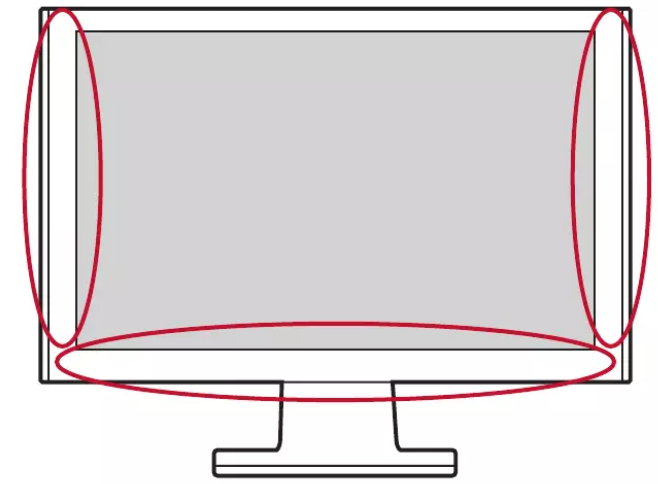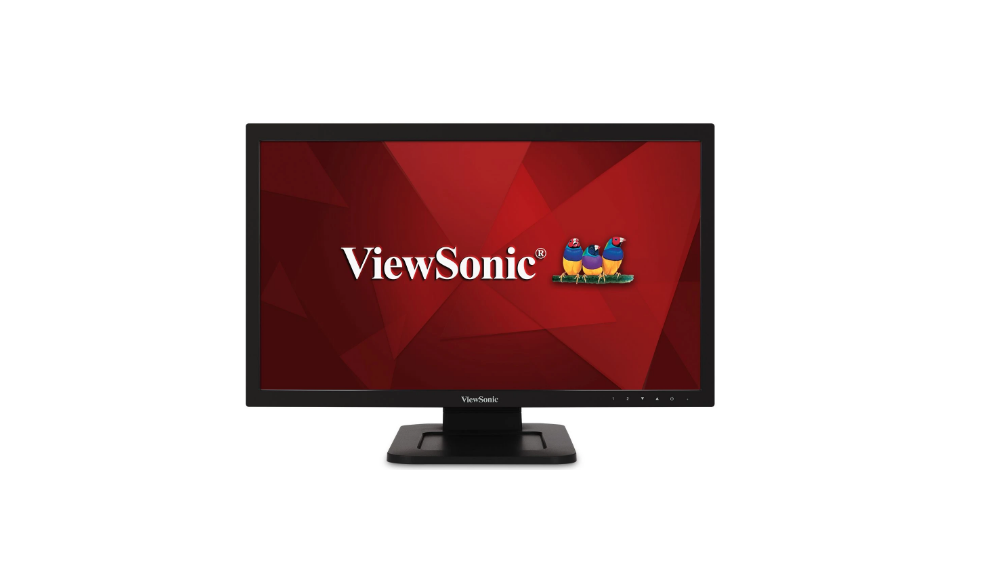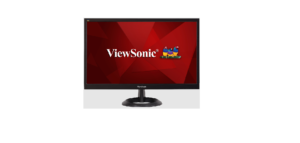Viewsonic TD2210 Touch Screen Monitor User Guide

Important Safety Instruction
- Read these instructions completely before using the equipment.
- Keep these instructions in a safe place.
- Heed all warnings and follow all instructions.
- Sit at least 18” / 45 cm from the LCD display.
- Always handle the LCD display with care when moving it.
- Never remove the rear cover. This LCD display contains high-voltage parts. You may be seriously injured if you touch them.
- Do not use this equipment near water. Warning: To reduce the risk of fire or electric shock, do not expose this apparatus to rain or moisture.
- Avoid exposing the LCD display to direct sunlight or another heat source. Orient the LCD display away from direct sunlight to reduce glare.
- Clean with a soft, dry cloth. If further cleaning is required, see “Cleaning the Display” in this guide for further instructions.
- Avoid touching the screen. Skin oils are difficult to remove.
Getting Started
Congratulations on your purchase of a ViewSonic LCD display.
NOTE: The word “Windows” in this user guide refers to Microsoft Windows operating system.
Package Contents
Your LCD display package includes:
- LCD display
- Power cord
- D-Sub cable
- DVI cable
- USB cable
- Quick Start Guide
- ViewSonic CD
- User Guide
- INF/ICM files*
- Registration information
- Additional software (Optional)
IMPORTANT:
- The word “Windows” in this user guide refers to the Microsoft Windows operating system.
- Visit the “Download” section of the monitor product page on the ViewSonic website to download your monitor drivers.
- Don’t forget to register your ViewSonic monitor! Simply login to the ViewSonic website in your region and click on the “Support” tab on the front page.
- Save the original box and all packing material for future shipping needs.
Quick Installation
- Connect video cable
- Make sure both the display and computer are turned OFF.
- Remove rear panel covers if necessary.
- Connect the video cable from the display to the computer. Macintosh users: Models older than G3 require a Macintosh adapter. Attach the adapter to the computer and plug the video cable into the adapter. To order a ViewSonic®
- Macintosh adapter, contact ViewSonic Customer Support.
- Connect power cord (and AC/DC adapter if required)

- Turn ON the display and computer Turn ON the display, then turn ON the computer.
NOTE: Windows users may receive a message asking them to install the INF file. To download the file, visit the “Download” section of the monitor product page on the ViewSonic website.
- Windows users: Set the timing mode (example: 1024 x 768) For instructions on changing the resolution and refresh rate, see the graphics card’s user guide.
- Installation is complete. Enjoy your new ViewSonic display!
Additional Software Installation (Optional)
- Load the ViewSonic CD on your CD/DVD drive.
- Double click on the “Software” folder and choose an application, if desired.
- Double click on the Setup.exe file and follow the onscreen instructions to complete the simple installation.
Control of the Touch Function
- Before using the touch function, make sure the USB cable is connected and the Windows operating system is started.
- When the touch function is active, end users must not use sharp-pointed pen or knife to touch the surface of screen.

Wall Mounting (Optional)
NOTE: For use only with UL Listed Wall Mount Bracket. To obtain a wall-mounting kit or height adjustment base, contact ViewSonic or ® your local dealer. Refer to the instructions that come with the base mounting kit. To convert your LCD display from a desk-mounted to a wall-mounted display, do the following:
- Verify that the power button is turned Off, then disconnect the power cord.
- Lay the LCD display face down on a towel or blanket.
- Remove the base. (Screws removal might be required.)
- Find and identify one of the following VESA mount interfaces (a,b,c) located on the back of your display.Attach the mounting bracket from the VESA compatible wall mounting kit using screws of the appropriate length.
 Attach the LCD display to the wall, following the instructions in the wall-mounting kit
Attach the LCD display to the wall, following the instructions in the wall-mounting kit
Using the Display
Setting the Timing Mode
Setting the timing mode is important for maximizing the quality of the screen image and minimizing eye strain. The timing mode consists of the resolution (example 1024 x 768) and refresh rate (or vertical frequency; example 60 Hz). After setting the timing mode, use the OSD (On-screen Display) controls to adjust the screen image. For optimal picture quality, please use the recommended timing mode specific to your display listed on the “Specification” page.
To set the Timing Mode:
- Setting the resolution: Access “Appearance and Personalization” from the Control Panel via the Start Menu, and set the resolution.
- Setting the refresh rate: See your graphics card’s user guide for instructions.
IMPORTANT: Please make sure that your graphics card is set to 60Hz vertical refresh rate as the recommended setting for most displays. Choosing a nonsupported timing mode setting may result in no image being displayed, and a message showing “Out of Range” will appear on screen.
OSD and Power Lock Settings
- OSD Lock: Press and hold [1] and the up arrow ▲ for 10 seconds. If any other buttons are pressed the message OSD Locked will display for 3 seconds.
- OSD Unlock: Press and hold [1] and the up arrow ▲ again for 10 seconds.
- Power Button Lock: Press and hold [1] and the down arrow ▼ for 10 seconds. If the power button is pressed the message Power Button Locked will display for 3 seconds. With or without this setting, after a power failure, your display’s power will automatically turn ON when power is restored.
- Power Button Unlock: Press and hold [1] and the down arrow ▼ again for 10 seconds.
Adjusting the Screen Image
Use the buttons on the front control panel to display and adjust the on-screen OSD
control settings.
Standby Power On/Off
Power light
Blue = ON
Amber = Power Saving
- Displays the Main Menu or exits the control screen and saves adjustments.
- Displays the control screen for the highlighted control. Also a shortcut to Auto Input toggle (D-Sub or HDMI). ▲/▼
- Scrolls through menu options and adjusts the displayed control settings. Blue Light Filter (▼) / ViewMode (▲)
Do the following to adjust the display setting:
- To display the Main Menu, press button [1].
NOTE: All OSD menus and adjustment screens disappear automatically after about 15 seconds. This is adjustable through the OSD timeout setting in the setup menu.
- To select a control to adjust, press ▲ or ▼ to scroll up or down in the Main Menu.
- After the desired control is selected, press button [2].
- To save setting adjustments and exit the menu, press button [1] until the OSD disappears.
The following tips may help you optimize your display:
- Adjust the computer’s graphics card to support a recommended timing mode (refer to “Specifications” page for recommended setting specific to your display). To find instructions on “changing the refresh rate”, please refer to the graphics card’s user guide.
- If necessary, make small adjustments using H. POSITION and V. POSITION until the screen image is completely visible.
Main Menu Controls
Navigate through menu items by using the up/down ▲/▼ buttons.
NOTE: Check the Main Menu items on your display OSD and refer to Main Menu Explanation below.
Main Menu Explanation
NOTE: The Main Menu items listed in this section indicate whole Main Menu items on all models. For the actual Main Menu details corresponding to your product refer to the items on your display’s OSD Main Menu.
- Audio Adjust
adjusts volume, mutes sound, or toggles between inputs if you have more than one source. - Auto Image Adjust
automatically sizes, centers, and fine tunes the video signal to eliminate waviness and distortion. Press the [2] button to obtain a sharper image.
NOTE: Auto Image Adjust works with most common video cards. If this function does not work on your display, then lower the video refresh rate to 60 Hz and set the resolution to its pre-set value.
- Brightness
adjusts the background black level of the screen image. - Color Adjust
provides several color adjustment modes, including preset color temperatures and a User Color mode which allows independent adjustment of red (R), green (G), and blue (B). The factory setting for this product is native. - Contrast
adjusts the difference between the image background (black level) and the foreground (white level). - Information
displays the timing mode (video signal input) coming from the graphics card in the computer, the display model number, the serial number, and the ViewSonic® website URL. See your graphics card’s user guide for instructions on changing the resolution and refresh rate (vertical frequency).
NOTE: VESA 1024 x 768 @ 60Hz (example) means that the resolution is 1024 x 768 and the refresh rate is 60 Hertz.
- Input Select
toggles between inputs if you have more than one computer connected to the display. - Manual Image Adjust
displays the Manual Image Adjust menu. You can manually set a variety of image quality adjustments. - Memory Recall
returns screen settings back to factory settings if the display is operating in a factory Preset Timing Mode listed in the Specifications section of this user guide.
Exception: This feature does not affect changes made with the Language Select or Power Lock setting.
- Setup Menu
adjusts On-screen Display (OSD) settings.
Specifications
LCD
- Type: TFT (Thin Film Transistor), Active Matrix 1920 x 1080 LCD, 0.24825 mm pixel pitch
Display size: Metric: 55 cm - Color Filter: RGB vertical stripe
- Glass Surface: Anti-Glare
Input Signal
- Video Sync: RGB analog (0.7/1.0 Vp-p, 75 ohms) / TMDS Digital (100 ohms)
- Separate Sync fh :24-83 kHz, f :50-76 Hz
Compatibility:
- PC: Up to 1920 x 1080 Non-interlaced
- Macintosh: Power Macintosh up to 1920 x 1080
Power
- Voltage: 100-240 VAC, 50/60 Hz (auto switch)
Display area
- Full Scan: 476.6 mm (H) x 268.11 mm (V) ,18.77” (H) x 10.56” (V)
Operating conditions
- Temperature: +32° F to +104° F (0° C to +40° C)
- Humidity: 20% to 90% (non-condensing)
- Altitude: To 10,000 feet
Storage conditions
- Temperature Humidity Altitude: -4° F to +140° F (-20° C to +60° C) 5% to 90% (non-condensing) To 40,000 feet
Dimensions
- Physical: 511 mm (W) x 365 mm (H) x 240 mm (D) 20.11” (W) x 14.37” (H) x 9.45” (D)
Wall
- Mount Distance: 100 x 100 mm
Weight
- Physical: 14.42 lbs (6.54 kg)
Power saving modes
- On: 29.5 W (Typical) (Blue LED)
- Off: <0.3 W
Cleaning the Display
- MAKE SURE THE DISPLAY IS TURNED OFF.
- NEVER SPRAY OR POUR ANY LIQUIDS DIRECTLY ONTO THE SCREEN OR HOUSING.
To clean the screen:
- Wipe the screen with a clean, soft, lint-free cloth. This removes dust and other particles.
- If the screen is still not clean, apply a small amount of non-ammonia, non-alcohol based glass cleaner onto a clean, soft, lint-free cloth, and wipe the screen.
To clean the casing:
- Use a soft, dry cloth.
- If the casing is still not clean, apply a small amount of a non-ammonia, non-alcohol based, mild non-abrasive detergent onto a clean, soft, lint-free cloth, then wipe the surface.
Disclaimer
- ViewSonic® does not recommend the use of any ammonia or alcohol-based cleaners on the display screen or case. Some chemical cleaners have been reported to damage the screen and/or case of the display.
- ViewSonic will not be liable for damage resulting from use of any ammonia or alcohol based cleaners.
Troubleshooting
No power
- Make sure the power button (or switch) is ON.
- Make sure A/C power cord is securely connected to the display.
- Plug another electrical device into the power outlet to verify that the outlet is supplying proper voltage.
Power is ON but no screen image
- Make sure the video cable supplied with the display is properly secured to the video output port on the back of the computer. If the other end of the video cable is not attached permanently to the display, properly secure it to the display.
- Adjust brightness and contrast.
- If you are using an Macintosh older than G 3, you need a Macintosh adapter.
Wrong or abnormal colors
- If any colors (red, green, or blue) are missing, check the video cable to make sure it is securely connected. Loose or broken pins in the cable connector could cause an improper connection.
- Connect the display to another computer.
- If you have an older graphics card, contact ViewSonic® for a non-DDC adapter.
Control buttons do not work
- Try pressing only one button at a time.


 Attach the LCD display to the wall, following the instructions in the wall-mounting kit
Attach the LCD display to the wall, following the instructions in the wall-mounting kit

